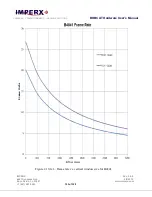
CAMERAS FRAME GRABBERS IMAGING SOLUTIONS
BOBCAT Hardware User’s Manual
IMPERX
Rev. 2.0.9
6421 Congress Ave.
4/8/2014
Boca Raton, FL 33487
www.imperx.com
+1 (561) 989-0006
168 of 329
2.6
EXTERNAL TRIGGER
2.6.1 Triggering Inputs
In the normal mode of operation, the camera is free running. Using the trigger mode
allows the camera to be synchronized to an external timing pulse. There are three
input modes available for external triggering – software (CC), internal (pulse
generator), and external. Please note that the desired trigger input has to be mapped
to corresponding camera input. For more information, please refer to the I/O Control
section.
-
“
External
” – the camera receives the trigger signal coming from the connector
located on the back of the camera.
-
“
Computer
” – the camera receives the trigger signal command from the frame-
grabber.
-
“
Internal
” – the camera has a built in programmable pulse generator – refer to
“Pulse Generator” section. In Internal triggering mode the camera receives the
trigger signal from the internal pulse generator.
-
“
Software
” – the camera receives the trigger signal which is computer
generated. This input is available only for GigE Cameras. The camera expects a
one clock cycles pulse generated by the computer. The trigger exposure is
internal register controlled. Pulse duration exposure is not allowed.
2.6.2 Acquisition and Exposure Control
For each trigger input the user can set the trigger edge, the over-trigger conditions,
the de-bounce (de-glitch) time, the exposure time, the exposure delay, and the
number of frames captured.
1.
“
Triggering Edge
” – the user can select the active triggering edge:
-
“
Rising
” – the rising edge will be used for triggering
-
“
Falling
” – the falling edge will be used for triggering
2.
“
De-bounce
” – the trigger inputs are de-bounced to prevent multiple triggering
from ringing triggering pulses. The user has eight choices of de-bounce interval:
-
“
Off
” – no de-bounce (default)
-
“
10
”
µ
s, “
50
”
µ
s, “
100
”
µ
s, “
500
”
µ
s de-bounce interval
-
“
1.0
” ms, “
5.0
” ms, “
10.0
” ms de-bounce interval
3.
“
Trigger Overlap
” – if the next trigger pulse arrives while the previous
triggering cycle is in process, the user has three options:
















































